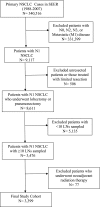The number of lymph node metastases as a prognostic factor in patients with N1 non-small cell lung cancer
- PMID: 21292754
- PMCID: PMC3148795
- DOI: 10.1378/chest.10-2885
The number of lymph node metastases as a prognostic factor in patients with N1 non-small cell lung cancer
Abstract
Background: Lymph node (LN) status is an important component of staging; it provides valuable prognostic information and influences treatment decisions. However, the prognostic significance of the number of positive LNs in N1 non-small cell lung cancer (NSCLC) remains unclear. In this study we evaluated whether a higher number of positive LNs results in worse survival among patients with N1 disease.
Methods: The Surveillance, Epidemiology, and End Results database was used to identify 3,399 patients who underwent resection for N1 NSCLC. Subjects were categorized into groups based on the number of positive nodes: one, two to three, four to eight, and more than eight positive LNs. The prognostic significance of the number of positive LNs in relation to survival was evaluated using the Kaplan-Meier method. Stratified and Cox regression analysis were used to evaluate the relationship between the number of positive LNs and survival after adjusting for potential confounders.
Results: Unadjusted survival analysis showed that a greater number of N1 LNs was associated with worse lung cancer-specific (P < .0001) and overall (P < .0001) survival. Mean lung cancer-specific survival was 8.8, 8.2, 6.0, and 3.9 years for patients with one, two to three, four to eight, and more than eight positive LNs, respectively. Stratified and adjusted analysis also showed the number of N1 LNs was an independent predictor of survival after controlling for potential confounders.
Conclusion: The number of positive LNs is an independent prognostic factor of survival in patients with N1 NSCLC. This information may be used to further stratify patients with respect to risk of recurrence in order to determine postoperative management.
Figures


Similar articles
-
Validation of the lymph node ratio as a prognostic factor in patients with N1 nonsmall cell lung cancer.Cancer. 2011 Oct 15;117(20):4724-31. doi: 10.1002/cncr.26093. Epub 2011 Mar 30. Cancer. 2011. PMID: 21452193 Free PMC article.
-
Lymph node ratio as a prognostic factor in elderly patients with pathological N1 non-small cell lung cancer.Thorax. 2011 Apr;66(4):287-93. doi: 10.1136/thx.2010.148601. Epub 2010 Dec 2. Thorax. 2011. PMID: 21131298 Free PMC article.
-
Significance of accurate hilar and intrapulmonary lymph node examination and prognostication in stage IA-IIA non-small cell lung cancer, a retrospective cohort study.World J Surg Oncol. 2020 Sep 30;18(1):258. doi: 10.1186/s12957-020-02027-y. World J Surg Oncol. 2020. PMID: 32998771 Free PMC article.
-
Number of lymph nodes and metastatic lymph node ratio are associated with survival in lung cancer.Ann Thorac Surg. 2012 May;93(5):1614-9; discussion 1619-20. doi: 10.1016/j.athoracsur.2012.01.065. Epub 2012 Mar 20. Ann Thorac Surg. 2012. PMID: 22440365 Free PMC article.
-
Postoperative survival and the number of lymph nodes sampled during resection of node-negative non-small cell lung cancer.Chest. 2005 Sep;128(3):1545-50. doi: 10.1378/chest.128.3.1545. Chest. 2005. PMID: 16162756
Cited by
-
Are we ready to use biomarkers for staging, prognosis and treatment selection in early-stage non-small-cell lung cancer?Transl Lung Cancer Res. 2013 Jun;2(3):208-21. doi: 10.3978/j.issn.2218-6751.2013.03.06. Transl Lung Cancer Res. 2013. PMID: 25806234 Free PMC article. Review.
-
Adjuvant chemotherapy for resected non-small-cell lung cancer: future perspectives for clinical research.J Exp Clin Cancer Res. 2011 Dec 29;30(1):115. doi: 10.1186/1756-9966-30-115. J Exp Clin Cancer Res. 2011. PMID: 22206620 Free PMC article. Review.
-
Towards More Structure: Comparing TNM Staging Completeness and Processing Time of Text-Based Reports versus Fully Segmented and Annotated PET/CT Data of Non-Small-Cell Lung Cancer.Contrast Media Mol Imaging. 2018 Nov 1;2018:5693058. doi: 10.1155/2018/5693058. eCollection 2018. Contrast Media Mol Imaging. 2018. PMID: 30515067 Free PMC article.
-
The impact of a novel lung gross dissection protocol on intrapulmonary lymph node retrieval from lung cancer resection specimens.Ann Diagn Pathol. 2014 Aug;18(4):220-6. doi: 10.1016/j.anndiagpath.2014.03.005. Epub 2014 Apr 26. Ann Diagn Pathol. 2014. PMID: 24866232 Free PMC article.
-
Impact of lymph node management on resectable non-small cell lung cancer patients.J Thorac Dis. 2017 Mar;9(3):666-674. doi: 10.21037/jtd.2017.02.90. J Thorac Dis. 2017. PMID: 28449474 Free PMC article.
References
-
- Jemal A, Seigel R, Xu J, Ward E. Cancer statistics, 2010. CA Cancer J Clin. 2010;60(5):277–300. - PubMed
-
- Wisnivesky JP, Henschke CI, Swanson S, et al. Limited resection for the treatment of patients with stage IA lung cancer. Ann Surg. 2010;251(3):550–554. - PubMed
-
- Mountain CF, Dresler CM. Regional lymph node classification for lung cancer staging. Chest. 1997;111(6):1718–1723. - PubMed
-
- Edge SB, Byrd DR, Compton CC, Fritz AG, Greene FL, Trotti A, editors. AJCC Cancer Staging Manual. 7th ed. New York, NY: Springer; 2010.
-
- Martini N, Flehinger BJ, Nagasaki F, Hart B. Prognostic significance of N1 disease in carcinoma of the lung. J Thorac Cardiovasc Surg. 1983;86(5):646–653. - PubMed
Publication types
MeSH terms
Grants and funding
LinkOut - more resources
Full Text Sources
Medical

